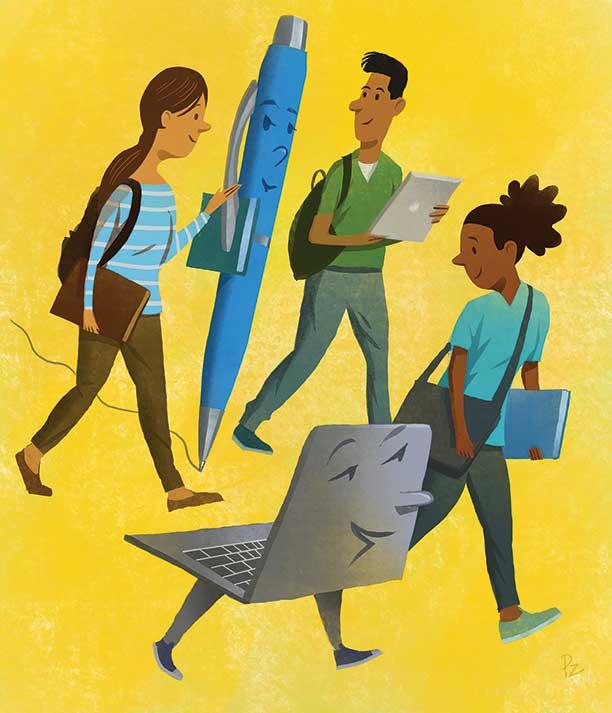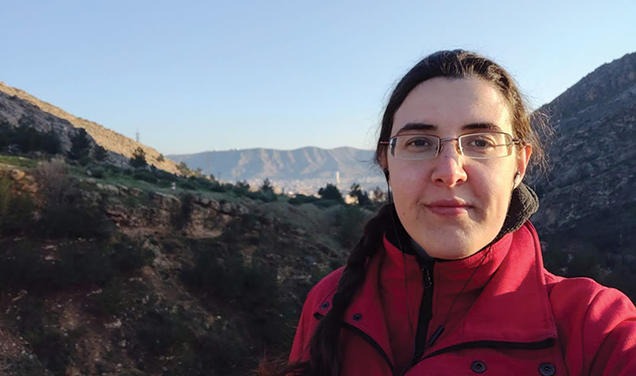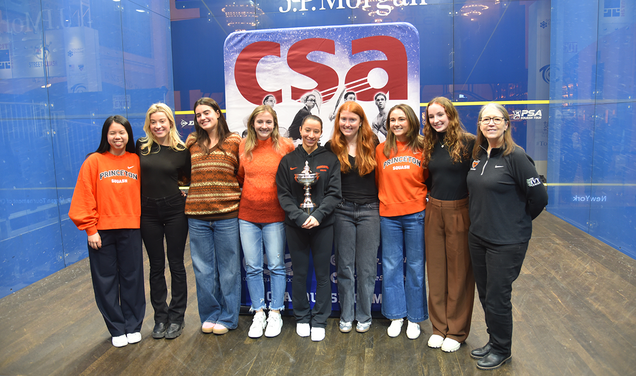Twenty years ago, PAW reported on a groundbreaking change to Firestone Library’s reference room: Each desk had been equipped with an outlet for a laptop computer.

“Technology is booming in the library,” PAW correspondent Ann Waldron wrote with enthusiasm, while assuring that Princeton hadn’t “given up on the book and gone completely high-tech.”
Today, laptops are everywhere on Princeton’s campus — sometimes glowing from the back rows at dance performances and the bleachers at football games — and increasingly in classes and precepts.
But just as PAW readers feared that Princeton had lost something — had “given up on the book” — by accepting laptops in the late 1990s, professors and students in more recent years continue to worry about potential drawbacks. Do laptops help students take more detailed notes, or do they drag attention away from the professor and down the rabbit hole of the internet?
The debate has existed in colleges across the country since laptops first became classroom fixtures in the early 2000s. At Princeton, professors’ concerns pushed the Faculty Committee on the Course of Study to discuss the issue in a meeting in the fall of 2009. It concluded that individual professors should make their own decisions on whether to ban laptops in the lecture hall, a policy that stands today.
In 2014, psychologists published a study on laptop note-taking in a Princeton lecture hall. Even when distractions were controlled for by disconnecting computers from the internet, students who used laptops performed worse on conceptual questions about the lecture than students who took notes with paper. The researchers concluded that using laptops to take notes entails “shallower” mental processing than traditional pen and paper.
English professor William Gleason said he thinks that more faculty have moved to ban laptops in recent years — but no clear data on the question exist. (Gleason noted that he doesn’t ban laptops from his classes.)
Some students choose to rely on handwritten notes, even in courses where computers are allowed. “Even though I can’t write everything down at the same speed,” said Katherine Ross ’22, “I feel like I understand concepts better and also remember them without needing to revise as much.”
For engineering students, this can be a practical decision: It’s easier to write symbols and diagrams than to create them on a computer. For others, the presence of laptops interrupts a focused environment in the classroom. “The physical barrier of a screen between the professor and me alone makes it more difficult for me to concentrate,” Abbie Minard ’20 said.
Psychology professor Nicole Shelton has described her view from the front of McCosh 50 as “looking over a sea of glowing, white apples.”
Ross added that using pen and paper helps to preempt the temptation to multitask. “I always tell myself I’m multitasking, but then I look up and I’ve zoned out for 10 minutes and am totally confused,” she said.
Professor emeritus Harvey Rosen, whose Introduction to Microeconomics course regularly drew more than 400 students, said he banned laptops for many years and received essentially no pushback. “Even the anonymous course evaluations include basically no criticisms of this policy,” Rosen said.
Yet many students continue to find laptops useful. In large lectures where computers are allowed, most students will be typing on a keyboard rather than writing with a pen. Psychology professor Nicole Shelton has described her view from the front of McCosh 50 as “looking over a sea of glowing, white apples.”
Laptops offer digital conveniences: the ability to write more and write faster, to search quickly for a term or pull up a helpful article. “If I’m trying to take handwritten notes I literally cannot keep up with the professor, and thus dedicate so much time to trying to write everything down quickly that I lose some understanding of the material,” noted Camellia Moors ’22.
And for students with learning or physical disabilities, laptops and tablets can be invaluable necessities for taking notes. One problem with laptop bans is that students with disabilities are either unable to take notes effectively or, if they request accommodations, have to disclose their disability by using a laptop in class.
Associate professor Casey Lew-Williams, who teaches his developmental psychology course in a large McCosh lecture hall, addresses concerns about distraction and accessibility by dividing the classroom. The left section of seats is pen-and-paper only — reserved for students who would be distracted by others’ screens. Students can use laptops in the rest of the room.
“I want students to take in information in a way that works for them, and I don’t want students to have to ‘out’ their learning disability if they in fact need to use a laptop,” Lew-Williams explained. “If this means that students type continuously on a computer, fine. If they want to download a journal article I’m describing, fine. If they want pen and paper, fine.”











0 Responses